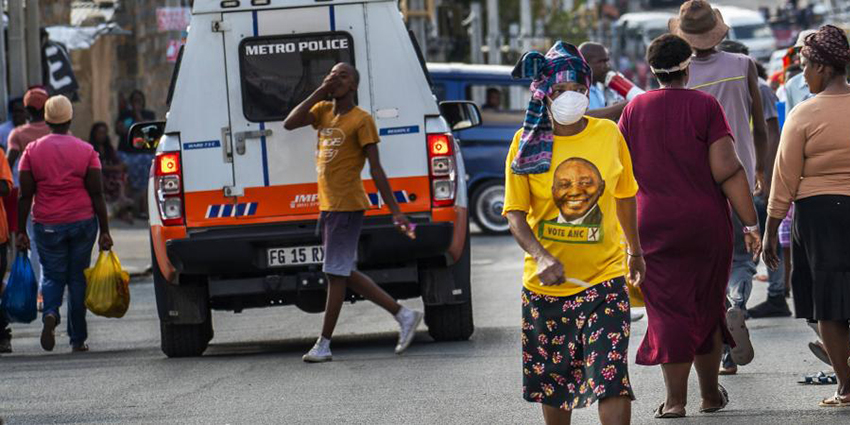
ADA(1), Inpulse(2) and the Grameen Crédit Agricole Foundation have joined forces to closely monitor and analyze the effects of the COVID-19 crisis among our partners around the world. This monitoring will be carried out periodically throughout the year 2020 with the purpose of evaluating the evolution and trend of both the effects of the crisis and the financial needs and adaptation measures implemented by our partners. We hope with this constant and close analysis to contribute, at our level, to the structuring of strategies and solutions according to the needs of our stakeholders, as well as the dissemination and exchange of information between the different actors in the sector for the joint construction of comprehensive and systematic solutions.
This article is based on the responses provided between May 18 and May 27, 2020 by 110 partners. Which are present in 47 countries distributed between Europe, Africa, Asia and Latin America, 5 Regions(3) and 13 Sub-regions of the world(4). In our analysis, we addressed 46% of very small MFIs, with less than 5 million assets (Tier 3), 47% of medium size, with an amount of assets between 5 and 50 million (Tier 2) and 7% with a size greater than 50 million assets (Tier 1)(5).
In Summary
The current period leaves no MFI or region of the world indifferent. The crisis related to COVID-19 has struck at the heart of most microfinance activities. All of the institutions surveyed have faced common problems because of the crisis: difficulties in disbursements, collection of reimbursements and meeting with clients, among others. These deeply operational activities, which are closely linked to client contact and meeting with customers, have financial consequences for MFIs. Portfolio and risk management are among the first short-term challenges raised by the crisis according to more than 80% of our partners.
However, pronounced regional differences emerge from this research. The health crisis, which is constantly evolving, does not have the same impact on all regions of the world, and not with the same intensity. On the operations side, for instance, the difficulty or impossibility to collect savings is not an issue for all. This concerns 56% of the surveyed MFIs in Sub-Saharan Africa and 60% of those in South Asia, whereas the matter is hardly mentioned in other regions, if not even mentioned. This depends on the constitution of the local market, and on the capacity for institutions to offer this product to their customers, according to the legislation in force. On the restrictions caused by the crisis, we note that a high proportion of MFIs in LAC, Central Asia and the MENA region witness that it is difficult for employees to move around or to meet clients in branches, contrary to MFIs in South East Asia or Sub-Saharan Africa.
The increase in the portfolio at risk is also having diverse impacts depending on the region. For instance, only 17% of MFIs in Central Asia, Europe and LAC record a PAR 30 + R that has more than doubled, while this is the case for 41% of MFIs in Sub-Saharan Africa, 27% of those in South Asia and 33% of those in MENA. However, none of the MFIs in the regions analyzed are free from the negative impact on their portfolios. This is due to the fact that globally, 80% of the respondents indicated a deterioration in portfolio quality, this impact represents a challenge for the entire sector in the short and medium term.
To address these issues, the financial needs of MFIs also vary. While 58% of the surveyed MFIs express additional funding needs, this is not as true for the EAC region. Indeed, 57% of the MFIs in this region report having no additional needs, and 22% consider that their funding needs have decreased. On the other hand, about 30% of the institutions in the MENA, SSA and LAC regions have funding needs that are between 20% and 50% higher than their expected.
In a broad way, the information collected demonstrates the proactivity of MFIs facing the crisis. All around the world, MFIs have multiplied adjustment measures to adapt to the crisis. The institutions have chosen not to remain passive when facing the consequences of the global economic downturn, for which they have constituted crisis management and monitoring committees, elaborated continuity plans and established debates with all interested parties. Finally, beyond the conjunctural difficulties, the reflections led by most of our partners are also directed towards new opportunities for the future, with for example the targeting of new markets or the development of new products. This could contribute in the future to greater flexibility for our partners, although this remains to be confirmed.
The impact of the COVID-19 crisis on the microfinance sector: the view of different MFIs around the world
The rigor of the containment measures is still variable between the different countries. 44% indicated that in their countries there are almost total lockdown and total restriction of movement. 46% of our partners, mainly those located in the SSA and LAC region, reported limited lockdown and partial movement restrictions. In contrast, 10% of the partners, mainly those located in LAC, stated that there are no or very few containment measures (no lockdown and no travel restrictions). The context of each region is different and largely, or totally, determined by the actions established by government authorities. While in the EAC region there seems to be greater uniformity in containment measures, it is not the same in Latin America where restrictive containment measures have been established in some countries while in others this type of measure has not yet been contemplated.
Another important aspect to consider is that the process of spreading the pandemic has been gradual between the different regions of the world. The COVID-19 crisis did not affect all regions at the same time. At the end of 2019, the virus was widely spread in China, in March it had been controlled in Asia, however, at the same time, Europe was becoming the new epicenter of the pandemic and the World Health Organization (WHO) declared the virus as “global pandemic”(6). Currently, America and Africa are being strongly affected. The evolution of the pandemic in the different regions of the world also determines in a significant way the type of responses provided by our partners, their level of affectation and surely the evolution of some of its most relevant indicators. Trends on which we will be paying attention in our next surveys and analyzes.
The COVID-19 crisis caused net slowdown to even impossibility of carrying out essential activities by our partners
82% of our partners reported having difficulty/impossibility to collect loan repayments as usual. This difficulty seems to impact partners from all regions but more significantly those located in MENA (100%), SSA (85%) and LAC (81%). The second most relevant difficulty, pointed out by 80% of our partners, is the impossibility of meeting clients in the field. Partners in the MENA region continue to be the most affected (100%), followed by those located in the EAC region (91%) and LAC (81%).
The third most relevant difficulty, manifested by 74% of our partners, relates to the disbursement of loans. This difficulty is a little more relevant among partners located in the MENA (89%), LAC (81%) and SSA (78%) regions.
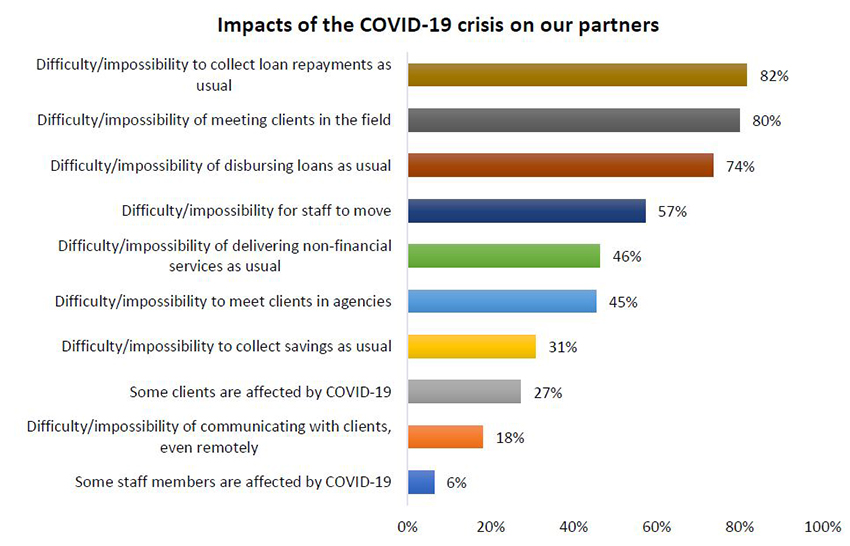
On the other hand, for 94% of our partners, communication with clients does not seem to be a significant difficulty. This may be due, as detailed below, to the significant use of digital systems and technology for remote communication. Likewise, 94% of MFIs reported that their employees are not contaminated with COVID-19. This represents a very satisfactory result of the measures taken at the beginning of the crisis by our partners for the protection of their staff. (8)
MFIs have faced different financial difficulties due to COVID-19
For 91% of our partners, the increasing portfolio at risk is the most significant financial difficulty they have had to face due to the pandemic. This is a difficulty present in all regions and all sizes of MFIs, however, it concerns 100% in partners located in the MENA region, 93% in those present in SSA and Asia, 91% and 86% of those located in the EAC and LAC regions respectively.
The outstanding portfolio reduction is also a relevant difficulty for 80% of our partners. This is mainly important for 93% of those located in the SSA region and 86% of those present in LAC.
The increase in the costs of materials and equipment and the lack of liquidity were difficulties faced by 46% and 39% of partners respectively.
“We think we may not have adequate funds for disbursements end of June if the situation improves in the field” – Partner in South Asia
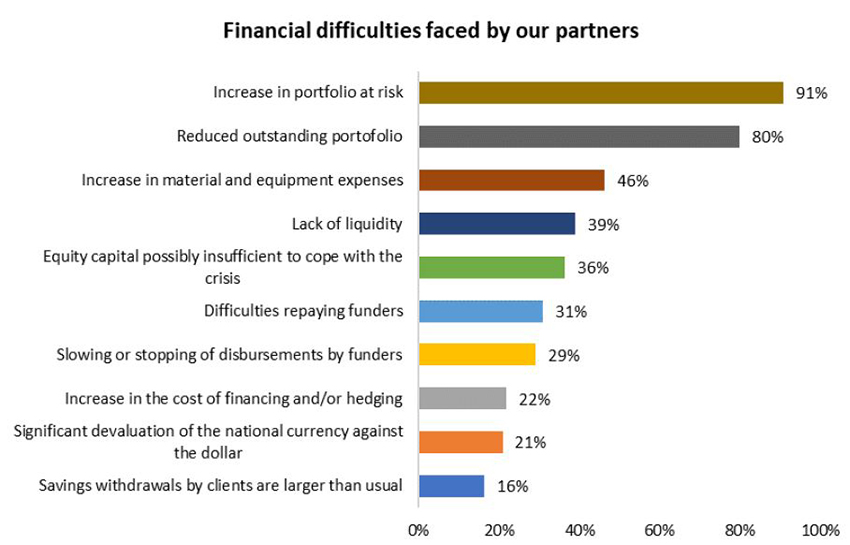
PAR 30 is already at this stage a major concern
80% of our partners indicated that their PAR 30 has increased due to the COVID-19 crisis. However, for 12% of the partners it has increased twice and for 25% of partners the PAR 30 has more than doubled. For 43% of the partners it has increased without being double. The partners mainly located in Asia, LAC and EAC are those who consider that their PAR 30 has increased without even reaching double, while most of the SSA partners reported an increase in PAR 30 of more than double, followed by partners in the MENA region.
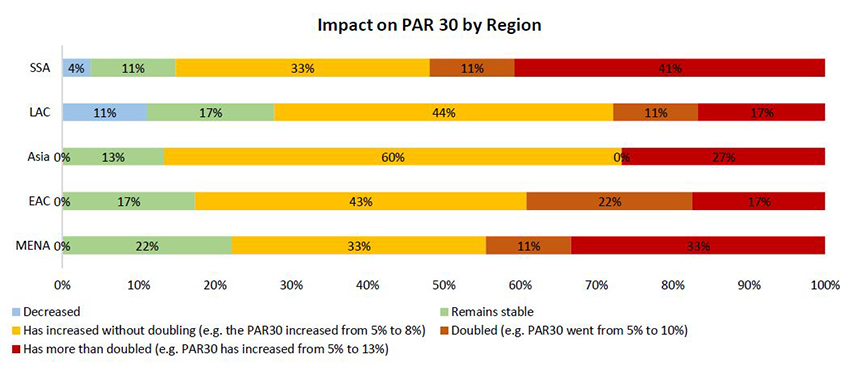
Strategies used to mitigate the crisis: From credit restructuring to the use of technological means
Our partners implement different financial measures and operations to mitigate and adapt to the crisis. 75% of them, mainly those located in Asia (87%), have carried out the credit restructuring with their clients. 65% of partners have slowed down or stopped the disbursement of credits. This measure has been mainly implemented by partners located in the LAC region (78%) and less used by those located in the MENA region (44%).
“Analysis of rescheduling requests in order to be able to accompany them with emergency loans but this is really on a case-by-case basis”- Partner in West Africa
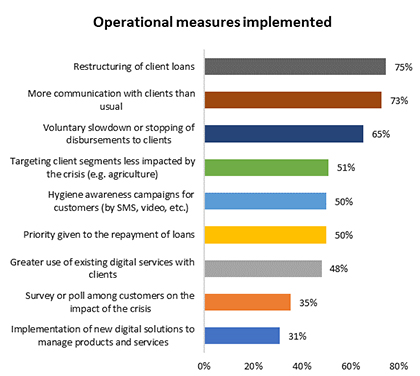 Another relevant strategy is the orientation of loans to clients in sectors less impacted by the crisis (for example, agriculture). This is a measure carried out by 51% of the partners, mainly those located in the SSA and EAC region. In addition, 50% give priority to repayment of credits.
Another relevant strategy is the orientation of loans to clients in sectors less impacted by the crisis (for example, agriculture). This is a measure carried out by 51% of the partners, mainly those located in the SSA and EAC region. In addition, 50% give priority to repayment of credits.
Likewise, communication with customers is a priority strategy among our partners. 73% have increased communication with clients and 50% have hygiene awareness campaign for clients (by SMS, video, etc.).
Technology is used as an important tool to face the crisis. Partners use existing digital solutions (by 48% of partners) or new solutions (by 31% of partners) for communication with customers as well as the management of financial products and services.
“We plan to improve the use of digital approaches to service provision, help clients for product marketing and business diversifications (…)”- Partner in South Asia
Strategies for the management of human talent: From hygiene measures to the use of technological means
90% of the partners have made the provision of sanitary equipment to staff. Office hygiene and disinfection measures are carried out by 82% and 70% of partners, respectively.
The organization of work times and travels to the field is indicated as another measure of great importance. 71% of the partners, mainly those located in the MENA, LAC and Asia region, implemented telework as much as possible. 66% of partners restricted or prohibited movement in the field. 54% of the partners, mainly located in the MENA and LAC region, have reduced working hours and 52% of them have reduced customer service hours in the agencies.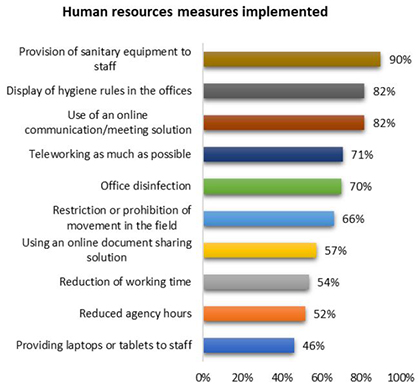
The use of digital to maintain communication and work activities with employees is also relevant. 82% use online meeting solutions and 57% use an online document sharing solution (mainly MENA and LAC partners). In addition, 46% provided their employees with work laptops or tablets (mainly those located in the MENA region, 78%).
“We established 2 WhatsApp communication groups with the staff (one for Singhala speaking and one for Tamil speaking). Then we had regular communications with them during the lock down” – Partner in South Asia
Crisis management measures
It can be considered that our partners carried out two main types of measures to manage the crisis COVID-19 in a relevant way. The first group contemplates the development of the following internal actions for the analysis, monitoring and follow-up of the effects of the crisis: 78% of the partners established an ad hoc management committee to monitor the crisis. These measures were particularly priority among partners in the SSA and MENA region. 75% of the partners, mainly those located in the Asia and SSA region, prepared a Business Continuity Planning. 74% of the partners, primarily those located in the EAC and MENA region, updated the Liquidity Plan. Furthermore, 65% carried out worst-case scenario simulation, this action being carried out more in the MENA region than in the SSA region.
In the second group are management measures aimed at requesting support from third parties. 53% of partners, mainly those located in MENA and LAC, requested financial support from funders / partners. 52%, notably those located in the MENA region, negotiated with Lenders to arrange loan repayment. Additionally, 37% of partners, particularly those located in Asia and SSA, requested technical support from funders / partners. These three actions have been less developed by partners located in the EAC region, of which the request for technical assistance seems to be the least relevant.
Additional funding needs from lenders: What is expected in the coming months?
30% of our partners stated that they had no additional financing needs and 12% indicated that their needs have decreased. These responses come mainly from partners located in the EAC region.
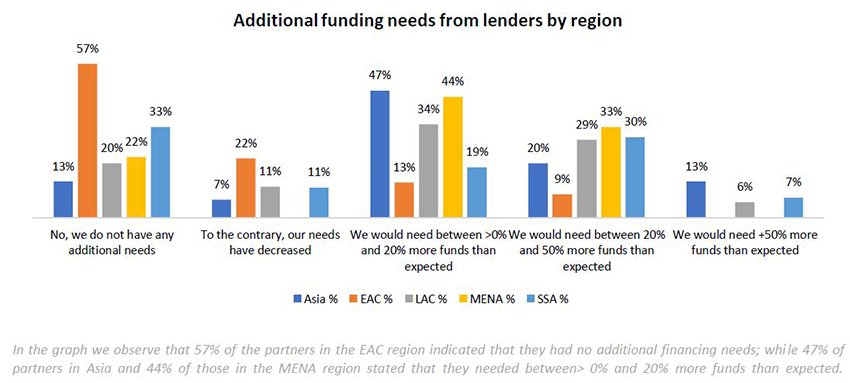
In contrast, 58% of the partners indicated that they would need financing for amounts greater than expected. Of these, 28%, mainly those located in the Asia and MENA region, reported that they would need between> 0% and 20% more funds than expected. 24%, mainly those present at MENA, stated that they would need between 20% and 50%. And 6% of partners, particularly those located in Asia, reported that they would need> 50% more funds than expected.
Looking forward to the near future: new markets or products
At this stage, the majority of our partners, equivalent to 57%, expressed interest in focusing their activities more on the Agricultural sector. This purpose seems to be particularly more relevant among partners in the SSA, Asia and EAC regions. This may be due to the increase in the needs of customers in this sector or to its identification as one of the production sectors least affected by the COVID-19 crisis (aspects already envisioned in the articles elaborated by Inpulse and the Grameen Credit Agricole Foundation) (9).
This assumption will be important to investigate in the following survey since the Agricultural sector let converge relevant economic, social and environmental factors, such as the allocation of an important part of the portfolio of our partners; the generation of significant amounts of jobs in some countries and the potential negative effects of climate change.
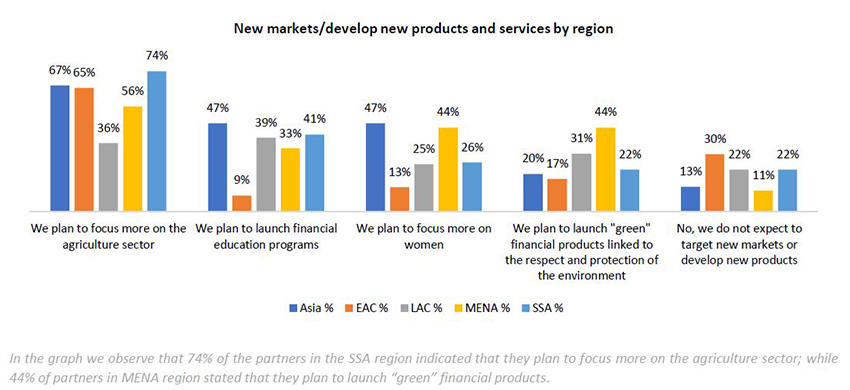
On the other hand, 37% of our partners plan to launch financial education programs and 27% plan to focus more on female clients.
“We plan to promote digital education for women clients (digital culture)” – Partner in South America
These are sectors that are traditionally addressed in the microfinance sector, however, 25% of our partners also indicated the interest in launching “green” financial products related to environmental protection. Could this interest demonstrate the increased awareness of our partners about the environmental problems linked to their actions? Does this represent the boost of green microfinance due to the COVID crisis? What type of green products would our partners be targeting? These are questions that could also be relevant to investigate in our next survey.
In contrast, the launch microinsurance related to hygiene, life, health or environmental risks does not seem relevant among our partners. Finally, 22% of our partners do not plan at the moment to focus on new markets or develop new products.
_____________________________________________________________________